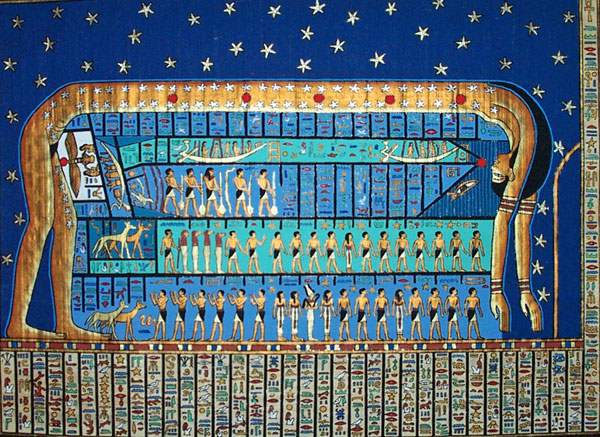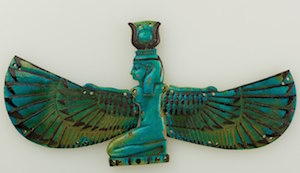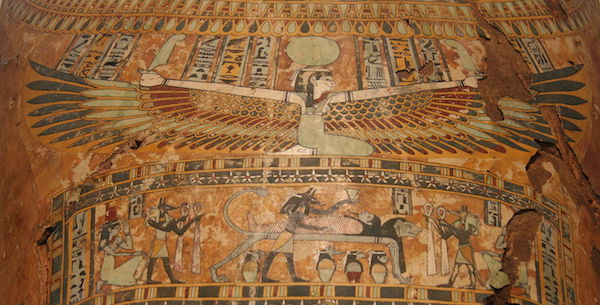Nut (Nuit, Nwt) was the personification of the sky and the heavens. She was the daughter Shu and Tefnut and the granddaughter of the creator god (Atum or Ra). Her husband/brother was Geb the earth god. However, she could also be said to be the mother of Ra.
The Coffin Texts refer to Nut as “she of the braided hair who bore the gods”. In one myth Nut gives birth to the Sun-god daily and he passes over her body during the day before being swallowed at night only to be reborn the next morning. According to another myth Ra used the Atet (or Matet) boat to travel across her body until noon and then used the Sektet boat until sunset.

Nut was also thought to be the mother of five children on the five extra days of the Egyptian calendar known as the “epagomenal days of the year”. Apparently, Ra became annoyed because Geb and Nut were locked in a perpetual embrace so he asked Shu to separate them. He also decreed that Nut should not bear children on any day in the calendar, but Thoth won the five “epagomenal” days days from the moon and Nut had five children: Osiris who was born on the first day, Horus the Elder on the second, Set on the third, Isis on the fourth, and Nephthys the last born on the fifth day. These days were a time of celebration all over Egypt.

She was a cow goddess who adopted some of the attributes of Hathor. When Ra became tired of ruling, Nut rose up into the heavens on her back in the form of a cow. However, she generally takes the form of a naked woman covered with stars, holding her body up in an arch, facing downwards. Her arms and legs were the pillars of the sky, and her hands and feet were thought to touch the ground at the four cardinal points on the horizon.
Geb is often depicted beneath her (sometimes ithphallyically). She was just portrayed as a woman wearing one of the hieroglyphs that made up her name, a round Egyptian pot.

Because of her role in the rebirth of the sun, Nut became a mother-like protector of the dead who was often painted on the inside lid of the sarcophagus, protecting the mummy. Her symbol, a wooden “maqet” (“ladder”) charm, was placed inside the tomb to help the deceased climb to the heavens.
There were many festivals to Nut through the year, including the “Festival of Nut and Ra” and the “Feast of Nut” and she appears in numerous depictions, yet no temples or specific cult centres are linked to her.
Bibliography
- The Complete Gods and Goddesses of Ancient Egypt (2003) Richard H. Wilkinson
- Egyptian Mythology (1997) Simon Goodenough
- The Gods of the Egyptians (1904) E Wallis Budge
- The Great Goddesses of Egypt (1999) Barbara S. Lesko
- Gods of Ancient Egypt (1996) Barbara Watterson
Copyright J Hill 2015